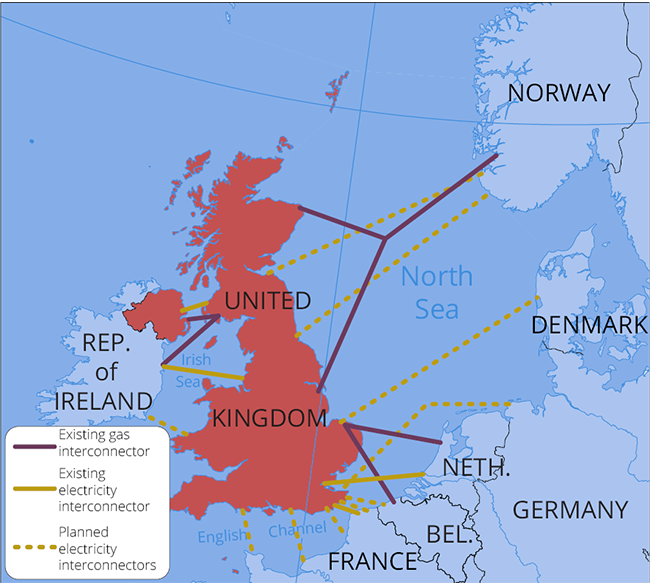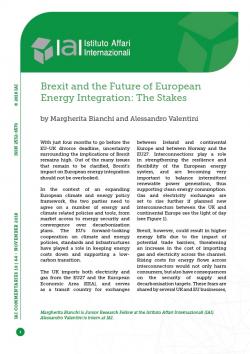Brexit and the Future of European Energy Integration: The Stakes
Brexit and the Future of European Energy Integration: The Stakes
Margherita Bianchi and Alessandro Valentini*
With just four months to go before the EU-UK divorce deadline, uncertainty surrounding the implications of Brexit remains high. Out of the many issues that remain to be clarified, Brexit’s impact on European energy integration should not be overlooked.
In the context of an expanding European climate and energy policy framework, the two parties need to agree on a number of energy and climate related policies and tools, from market access to energy security and convergence over decarbonisation plans. The EU’s forward-looking cooperation on climate and energy policies, standards and infrastructures have played a role in keeping energy costs down and supporting a low-carbon transition.
The UK imports both electricity and gas from the EU27 and the European Economic Area (EEA), and serves as a transit country for exchanges between Ireland and continental Europe and between Norway and the EU27. Interconnections play a role in strengthening the resilience and flexibility of the European energy system, and are becoming very important to balance intermittent renewable power generation, thus supporting clean energy consumption. Gas and electricity exchanges are set to rise further if planned new interconnectors between the UK and continental Europe see the light of day (see Figure 1).
Figure 1 | UK gas and electricity interconnectors, existing and planned

Source: UK Parliament, “Brexit: Energy Security”, in House of Lords Papers, No. 63 (29 January 2018), p. 21, https://publications.parliament.uk/pa/ld201719/ldselect/ldeucom/63/63.pdf.
Brexit, however, could result in higher energy bills due to the impact of potential trade barriers, threatening an increase in the cost of importing gas and electricity across the channel. Rising costs for energy flows across interconnectors would not only harm consumers, but also have consequences on the security of supply and decarbonisation targets. These fears are shared by several UK and EU businesses, a number of which have recently called on leaders to ensure that any Brexit deal include a comprehensive chapter on energy and climate.[1]
It is clear that both parties have an interest in an integrated energy market but shared interests are also suffering from an old dispute over principles. The EU does not want the UK to simply pick and choose from the EU acquis as this will likely give advantages to UK businesses. The UK government, on the other hand, does not want to give the impression of agreeing to limit elements of its sovereignty vis-à-vis the EU, itself among the primary reasons for the Brexit vote in the first place.
When it comes to the energy dossier, the Irish question is possibly the most problematic issue on the table. Brexit poses significant challenges for the Irish energy sector, its security, the maintenance of its emergency oil stocks and its regional integration within the European Internal Energy Market.
First of all, the country is closely linked to the UK gas market, importing around 42 per cent of its gas needs through an interconnector running from Scotland.[2] Secondly, Ireland’s continued permanence in the internal market is crucial for its electricity prices and important for the overall renewable energy targets set by the EU. If the UK does not end up remaining in the internal market, Ireland risks being cut-off from it, implying a greater need to invest in back-up capacity, as well as lower revenues from its exports of wind power and more volatile electricity prices.[3] To avoid isolation, Ireland is indeed considering the possibility of developing a 600 km underwater electricity interconnector between the island and France.
A second dimension of the Irish problem concerns the joint wholesale electricity market on the island – the Single Electricity Market (SEM) –, which the Republic of Ireland and Northern Ireland have established over a decade ago. SEM has allowed energy to be traded freely across the border, strengthening energy security and helping to keep prices down. A no-deal Brexit would threaten the border agreement reached between Ireland and Northern Ireland in 1998, potentially resulting in electricity blackouts and rising energy bills in the North.[4] In turn, this would likely hamper the preservation of the SEM and the construction of a north-south electricity interconnector on the island.
The UK Government has recently released a guidance note to rely on in the case of a no-deal outcome.[5] The documents do not go into much detail, but do nevertheless highlight a number of negative implications. In a no-deal scenario, EU energy law will not apply to the UK, which will consequently no longer play a role in the EU structure that supports its implementation – such as the Agency for the Cooperation of Energy Regulators (ACER). Similarly, European energy grant awards, such as those envisioned by the Connecting Europe Facility (CEF), would no longer be accessible to the UK after Brexit.
Integration in the field of climate and decarbonisation policies is another piece of the puzzle. The UK government has repeatedly given assurances of its intention to safeguard European environmental standards, no matter the outcome of the Brexit negotiations. The UK’s White Paper on the future relationship with the EU indeed stresses that “The UK’s world leading climate ambitions are set out in domestic law and are more stretching than those that arise from its current obligations under EU Law”, noting how “The UK will maintain these high standards after withdrawal”.[6]
One important issue in this domain concerns the EU Emissions Trading System (ETS). In case of a no-deal Brexit, around 1,000 installations and 140 UK administered aircrafts currently covered by the EU ETS would no longer participate.[7] These include power stations, oil refineries, offshore platforms as well as the iron and steel, cement and lime, paper, glass, ceramics and chemicals industries. The government is in this sense examining different options, depending whether the UK and the EU will reach an agreement or not.
In the first case, the UK could ask to remain in the EU’s ETS or would probably go for its own ETS connected to the European scheme.[8] In the event of a no-deal, the UK’s 2018 budget includes considerations for the introduction of a Carbon Emissions Tax applying to all stationary installations currently participating in the EU ETS, with a rate of 16 pounds per tonne of CO2 emitted above an installation’s emissions allowance.[9] This means that the total price would result from two separate and fixed carbon taxes (this new Carbon Emissions Tax and the carbon price floor the UK government aims to maintain and that has been frozen at 18 pounds a tonne until 2021). If, on the one hand, this corresponds to about the same amount polluters would pay considering today’s prices, on the other this system could prevent polluters from paying more if prices surge on the EU ETS system – as expected by traders – and thus much depends on what longer term solutions the government will present to keep coal off the system.[10]
Possible solutions on some pillars of the EU Clean Energy Package – such as the targets on renewables and energy efficiency – have not been addressed with a similar degree of accuracy. The White Paper does not identify solutions on the Effort Sharing Regulation – regulating emissions in fields that lie outside the scope of the EU ETS, including transport, buildings, agriculture, waste – and on the so-called LULUCF regulation – concerning land use, land-use change and forestry.
Moreover, both the EU Commission and the UK Government consider long-term net-zero greenhouse gas emission targets as fundamental to reach the Paris Agreement. However, as the EU adopted a joint National Determined Contribution (NDC) in 2015, both sides will have to clarify future scenarios, including the possibility of two new separate NDCs in order to meet the respective climate goals, similarly to the Norwegian or Icelandic NDCs.[11]
In this respect, it is hard to think that Brexit could result in positive outcomes for either side when it comes to the energy field. In the event of a no-deal scenario, risks will be particularly high, with adverse effects on energy prices, distribution and decarbonisation targets. In such a scenario, there is little doubt that the Republic of Ireland and Northern Ireland will be particularly exposed to the adverse fallout.
That being said, the UK and EU27 should – and likely would – continue to cooperate and ultimately find an agreement. Energy is just too sensitive a topic and it is in the fundamental interest of both sides to maintain, and continue to build on, the positive legacy of EU-UK cooperation in the energy field, particularly when it comes to preserving stable and cheap access to energy and updating the ambitious climate standards and targets.
* Margherita Bianchi is Junior Research Fellow at the Istituto Affari Internazionali (IAI). Alessandro Valentini is intern at IAI.
[1] British Irish Chamber of Commerce et al., Prioritising EU27/UK Cooperation on Climate Change and Energy, 4 September 2018, https://windeurope.org/?p=15412.
[2] Energy Institute, “Where Does Ireland’s Gas Come From and What Determines Its Price?”, in Ireland 2050: The Present – Questions, http://ireland2050.ie/questions/where-does-irelands-gas-come-from-and-what-determines-its-price.
[3] Georg Zachmann, “The Impact of Brexit on the Irish Energy System – Pragmatism vs. Principles”, in Bruegel Blog, 21 November 2017, http://bruegel.org/?p=22895.
[4] Adam Vaughan and Nick Hopkins, “No-Deal Brexit Could Result in Northern Ireland Blackouts, Leaks Reveal”, in The Guardian, 27 September 2018, https://gu.com/p/9fn95.
[5] UK Department of Exiting the European Union, How to Prepare If the UK Leaves the EU with No Deal, last updated 12 October 2018, https://www.gov.uk/government/collections/how-to-prepare-if-the-uk-leaves-the-eu-with-no-deal.
[6] UK Department of Exiting the European Union, The Future Relationship between the United Kingdom and the European Union (CM9593), last updated 17 July 2018, p. 40, https://www.gov.uk/government/publications/the-future-relationship-between-the-united-kingdom-and-the-european-union.
[7] UK Department for Business, Energy & Industrial Strategy, Meeting Climate Change Requirements If There’s No Brexit Deal, 12 October 2018, https://www.gov.uk/government/publications/meeting-climate-change-requirements-if-theres-no-brexit-deal/meeting-climate-change-requirements-if-theres-no-brexit-deal.
[8] Susanna Twidale, “Britain Looking at Four Options for Carbon Pricing after Brexit – Govt Official”, in Reuters, 17 October 2018, https://reut.rs/2CNEEBL.
[9] UK Treasury, Budget 2018 (HC1629), October 2018, p. 47, https://www.gov.uk/government/publications/budget-2018-documents.
[10] David Sheppard, “No-deal Brexit Will Spell £16-a-tonne Carbon Tax”, in Financial Times, 29 October 2018, https://www.ft.com/content/14606058-db9e-11e8-8f50-cbae5495d92b.
[11] Shane Tomlinson, “Brexit and Climate Cooperation: Implications for the Paris Agreement and Net-Zero”, in E3G Briefing Papers, October 2018, https://www.e3g.org/library/brexit-climate-cooperation-implications-for-paris-agreement-and-netzero.
-
Dati bibliografici
Roma, IAI, novembre 2018, 4 p. -
In:
-
Numero
18|64




